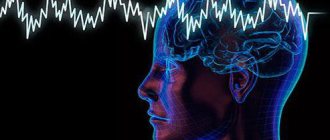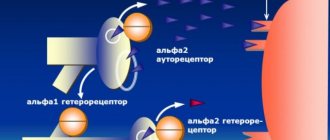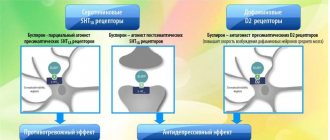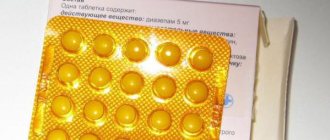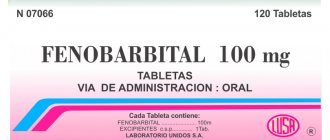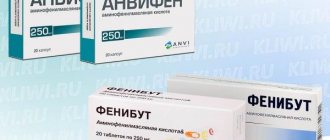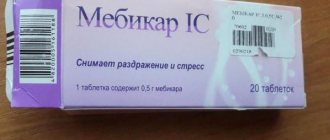general information
Valparin is an effective antiepileptic drug based on valproic acid. It is produced by a pharmaceutical company.
Drug group, INN, application
The drug belongs to the medicinal group of antiepileptic drugs, which are intended for long-term use in order to eliminate or reduce the frequency of seizures and epileptic attacks.
The international nonproprietary name of the drug determines the name of its active substance. In this case, the INN of Valparin is valproic acid. The medicine is used to relieve seizures and treat epilepsy. It is prescribed to both adults and children.
Release form, cost
The drug is produced in the form of long-acting tablets for internal use, film-coated. They have a round convex shape and are white in color. The package contains 30 or 100 tablets.
The retail price depends on the content of the active component in 1 tablet (300 or 500 mg) and their quantity in the package. Average prices for the drug in different pharmacies in Russian cities are presented in the table.
Pharmacy, city Concentration of the active substance Valparin, number of tablets per package Price in rubles
| Vitamin, St. Petersburg | 300 mg, No. 30 | 217 |
| Vitamin, St. Petersburg | 300 mg, No. 100 | 739 |
| Europharm LLC, Moscow | 300 mg, No. 100 | 705 |
| Laboratory of beauty and health, Moscow | 500 mg, No. 30 | 387 |
| BALTIKA-MED, St. Petersburg | 500 mg, No. 100 | 1365 |
| BALTIKA-MED, St. Petersburg | 300 mg, No. 100 | 695 |
| Apteka.ru, Volgograd | 300 mg, No. 30 | 221 |
| Apteka.ru, Rostov-on-Don | 300 mg, No. 100 | 681 |
Compound
The drug contains an active ingredient – valproate. It is presented in tablets in the form of sodium salt (sodium valproate) and valproic acid, 300 or 500 mg.
Additionally, the composition includes auxiliary components. Among them:
- silica;
- sodium saccharinate;
- glycerol;
- talc;
- cellulose;
- titanium dioxide;
- macrogol and others.
Release form and composition
The dosage form of the drug is long-acting tablets, film-coated: the shell is white, the outer layer and the white core stand out at the break;
at a dose of 300 mg – round, biconvex; at a dose of 500 mg - oblong, with a notch on both sides (4 pcs. in Al foil strips, 1 strip in a cardboard pack; 10 pcs. in Al foil strips, 1, 3, 5 or 10 strips in a cardboard pack ). 1 tablet contains:
- active ingredient: sodium valproate – 300 or 500 mg (sodium valproate – 200 or 333 mg + valproic acid – 87 or 145 mg);
- excipients: hypromellose, silicon dioxide hydrate, colloidal silicon dioxide, ethylcellulose, sodium saccharinate;
- film shell I: titanium dioxide, hypromellose, glycerol;
- film shell II: hypromellose, macrogol-1500, Eudragit E-100, Eudragit NE-30D, macrogol-1500, titanium dioxide, talc.
Indications and restrictions
The drug is used to treat adults and children. It is used as monotherapy and also as an additional agent in combination with other anticonvulsants. Indications for its use are:
Generalized or idiopathic epilepsy. It is hereditary and, as a rule, appears in childhood. The following forms are treated with the drug:- tonic;
- tonic-clonic;
- myoclonic;
- minor non-convulsive seizures (absences).
clonic;
The drug can also be used for the treatment and prevention of bipolar affective disorders (manic-depressive psychosis). This condition is observed only in adults.
In some cases, it is prohibited to take Valparin. Among its contraindications are:
- individual intolerance to the active substance or auxiliary components of the drug;
- severe liver pathologies (acute and chronic forms of hepatitis, liver failure);
- porphyrin disease;
- simultaneous use with mefloquine and drugs based on St. John's wort;
- children under 3 years of age;
- lactation period.
Indications for use
- Treatment of epilepsy of various origins;
- Relief of generalized and partial epileptic seizures, as well as the convulsive component in organic diseases of the brain;
- When there are changes in the behavior and character of the patient caused by epilepsy ;
- West syndrome , Lennox-Gastaut ;
- Childhood tics and febrile convulsions in children;
- In the complex treatment of manic-depressive psychosis occurring with bipolar symptoms and when the prescription of other drugs is ineffective.
Instructions for use
According to the instructions, Valparin is used both in adult practice and in pediatrics. The rules of administration and dosage are as follows:
- The tablets should be taken orally, preferably with meals. They are swallowed whole with liquid.
- The prescribed dose is divided into 2 doses. One-time use is possible if epilepsy is controlled.
- For elderly people, the dosage is determined depending on their general condition.
The dosage regimen depends on the age and weight of the patient:
- for adults and children weighing more than 25 kg, a daily dose of 5 to 15 mg per kg of weight is used, which is increased by 5 or 10 mg/kg after a week;
For children weighing less than 25 kg, 15-45 mg per 1 kg of weight is recommended.
If Valparin is replaced by another antiepileptic drug, it is administered gradually, increasing the dose over two weeks. In this case, the dosage of the previously taken medication is gradually reduced and then discontinued.
Use for liver dysfunction
Contraindicated: acute hepatitis; chronic hepatitis; history of liver disease.
Before starting treatment and during the first 6 months of therapy, periodic monitoring of liver function is necessary, especially in patients at risk.
Among the classical tests, the most important are those reflecting protein synthesis in the liver and especially the prothrombin index. If there is a significant decrease in the concentration of prothrombin, a marked decrease in the content of fibrinogen, blood clotting factors, an increase in the concentration of bilirubin and transaminase activity, treatment with Valparin® should be suspended.
The risk of side effects from the liver is increased during combination anticonvulsant therapy, as well as in children.
Early diagnosis is based primarily on clinical examination. In particular, two factors that may precede jaundice should be taken into account, especially in patients at risk:
- nonspecific general symptoms, usually appearing suddenly, such as asthenia, anorexia, extreme fatigue, drowsiness, sometimes accompanied by repeated vomiting and abdominal pain;
- recurrence of epileptic seizures during antiepileptic therapy.
The patient, and if it is a child, then his family, should be warned about the need to immediately notify the doctor about the occurrence of these symptoms. In addition to clinical examination, liver function testing should be performed immediately in such cases.
Side effects, signs of overdose
The medicine can provoke the development of various negative reactions. Most often, the following side effects occur while taking it:
- violation of the coordination of muscle movement (ataxia);
- reversible dementia;
- liver disorders;
- pancreatitis;
- confusion;
lethargy;
- convulsions, stupor;
- development of a coma;
- headaches and dizziness;
- Parkinson's disease (reversible);
- trembling of limbs;
- drowsiness, fatigue;
- irritability, aggression, hyperactivity;
- motor abnormalities;
- depressive states, psychosis;
- development of hallucinations;
- digestive problems (nausea, vomiting, diarrhea, increased appetite or, conversely, lack thereof), which occur at the beginning of taking the medicine and disappear over time;
- hematopoietic disorders (anemia, leukopenia, thrombocytopenia);
- bleeding, hematoma, hemorrhage;
- urinary incontinence syndrome;
- nystagmus, flashing of spots before the eyes;
- hearing problems;
- peripheral edema;
- abnormal hair loss;
- the appearance of excess weight;
- menstrual irregularities, enlarged mammary glands in women;
- vasculitis;
- angioedema;
- allergic reactions on the skin (itching, burning, rashes, urticaria, erythema).
Side effects
Drowsiness , dizziness , headache , dysarthria , encephalopathy , stupor, enuresis , impaired consciousness, changes in mental state, mood or behavior (aggression, depression , hallucinations , feeling tired, psychosis, unusual agitation, irritability, restlessness), nausea, vomiting, appetite disturbances, diarrhea , nystagmus , diplopia , anemia , leukopenia , weight gain or loss, allergic reactions , alopecia , dysmenorrhea , peripheral edema, skin rash.
Similar means
Popular analogues of Volparin are drugs based on valproic acid. Among them:
Depakine. An effective anticonvulsant, which is available in various dosage forms (syrup, tablets, powder for the preparation of solution for injection). There is even a type of drug that is gentle on the stomach (Depakine Enteric). Produced pharmaceutically. The cost of Depakine (500 mg) is 680 rubles.
- Convulex. A German medicine that, in addition to its antiepileptic effect, is also effective in preventing migraines. Available in the form of syrup, drops, injections and tablets. The price of the drug is from 340 (300 mg) to 510 (500 mg) rubles.
- Encorat Chrono. An Indian anticonvulsant drug based on valproate, produced only in tablet form. It has a more affordable price - from 180 to 440 rubles.
Only the attending physician can prescribe this or that drug, and he also determines the dosage and duration of the therapeutic course.
Reviews about Valparin
According to doctors, the appearance of chrono-forms of valproate ( Valparin chrono ) has significantly reduced the risk of side effects caused by a peak increase in the concentration of valproate in the blood and increased the effectiveness of therapy. At the same time, the tolerability of extended-release forms is comparable to slow-release drugs. Valparin XP is most effective in the treatment of generalized and convulsive tonic-clonic seizures .
The drug is also effective against secondary generalized and partial seizures. Valparin XP can be used both as mono and polytherapy for epileptic seizures of various forms of epilepsy , for primary generalized seizures . Refers to first-line drugs of choice. Its advantages include the relatively low cost of the original drugs.
Practical application experience
Expert opinion and reviews from patients who are taking or have taken Valparin.
Valparin contains sodium valproate. This is a substance that eliminates epileptic seizures of various types.
A special therapeutic effect is observed in primary generalized epilepsy. This drug rarely causes adverse reactions, and an overdose is possible only in case of violation of the doctor's instructions. That is why it is available in pharmacies only with a prescription. Compared to similar medications, this drug is slightly cheaper.
Evgeny Vladimirovich, specialist - neurologist
My daughter was prescribed medication for a diagnosis of partial epilepsy. The medicine is really very effective and even helps prevent attacks. They haven't made themselves known for six months now. Among the disadvantages is the relatively high cost of the drug.
Olga Alexandrovna, 40 years old
I am diagnosed with epilepsy. At the hospital, the doctor prescribed me Valparin. I've been drinking for a long time. I'm happy with the result, the tablets help a lot. However, side effects often occur: nausea, skin rashes.
Victor Vladimirovich, 45 years old
Patients who take Valparin claim that the drug is strong, so it must be taken exactly according to the dosage prescribed by a specialist. This is because the medicine can cause adverse reactions and overdose.
Based on reviews from doctors and patients, the advantages of the drug are high efficiency and availability.
Disadvantages include the high price and a large list of adverse reactions.
Valparin XP - really effective pills for epilepsy
special instructions
During therapy with Valparin HR, patients are regularly examined (every 3 months), determining the activity of liver transaminases, the level of amylase, platelets and bilirubin in the blood.
Due to the inhibition of platelet aggregation by valproic acid during bleeding, the risk of increased clotting time increases. In patients receiving sodium valproate, this likelihood of complications must be taken into account in the postoperative period. As a result of prolonged therapy with valproic acid, spontaneous hematomas and bleeding may develop, which requires immediate discontinuation of the drug.
Valparin XP can cause drug-induced pancreatitis and liver failure, mainly in the first six months of use, and therefore at the beginning of treatment it is necessary to monitor the condition of the pancreas, conduct liver tests, and monitor prothrombin levels.
With the use of sodium valproate, liver dysfunction is sometimes observed in children with epilepsy in combination with degenerative and metabolic diseases, organic damage to brain tissue and mental retardation. If they observe symptoms such as vomiting, jaundice, swelling, severe weakness, lethargy, the use of the drug should be stopped immediately.
While taking Valparin XP, the patient should be careful when performing types of work that require increased concentration and speed of psychomotor reactions.
Contraindications
High sensitivity to the drug, hepatitis , occurring in acute or chronic form, pancreatic diseases, hemorrhagic diathesis , porphyria , first trimester of pregnancy , severe thrombocytopenia , lactation period, age up to 3 years (for tablet form).
Take with caution in case of anemia , leukopenia , thrombocytopenia caused by inhibition of bone marrow hematopoiesis, renal failure , brain diseases with organic lesions, hypoproteinemia , congenital enzymopathy , mental retardation in children.
Pharmacodynamics and pharmacokinetics
Pharmacodynamics
A drug with antiepileptic action, has a muscle relaxant and sedative effect. The mechanism of action is to inhibit GABA transferase in the brain under the influence of valproic acid and reduce the reuptake of GABA , which leads to a decrease in the excitability of the motor areas of the brain and a decrease in the manifestation of the convulsive component. The therapeutic effect consists of normalizing the mental status of patients with various types of epilepsy and their mood, and has antiepileptic activity. It does not have a therapeutically significant hypnotic or sedative effect, does not inhibit the function of the respiratory center, does not affect blood pressure , kidney function, heart rate and body temperature.
Pharmacokinetics
The drug is quickly absorbed into the gastrointestinal tract , bioavailability is almost 100%. Communication with blood proteins is at the level of 90-95%. Penetrates through the BBB and into the cerebrospinal fluid. The half-life is 16 hours. It is excreted as a glucuronide mainly in the urine. Does not affect the process of biotransformation of estrogens vitamin K antagonists , progestogens .
Valparine oral solution
Instructions for medical use of the drug
Description of pharmacological action
An antiepileptic drug that has a central muscle relaxant and sedative effect. Shows antiepileptic activity in various types of epilepsy. The main mechanism of action appears to be related to the effect of valproic acid on the GABAergic system: the drug increases the content of gamma-aminobutyric acid (GABA) in the central nervous system (CNS) and activates GABAergic transmission. Therapeutic effectiveness begins with a minimum concentration of 40-50 mg/l and can reach 100 mg/l. At a concentration of more than 200 mg/l, a dose reduction is necessary.
Indications for use
In adults, as monotherapy or in combination with other antiepileptic drugs: - treatment of generalized epileptic seizures (clonic, tonic, tonic-clonic, absence seizures, myoclonic, atonic); Lennox-Gastaut syndrome; - treatment of partial epileptic seizures (partial seizures with or without secondary generalization); — treatment and prevention of bipolar affective disorders. In children, as monotherapy or in combination with other antiepileptic drugs: - treatment of generalized epileptic seizures (clonic, tonic, tonic-clonic, absence seizures, myoclonic, atonic); Lennox-Gastaut syndrome; - treatment of partial epileptic seizures (partial seizures with or without secondary generalization).
Release form
Oral solution 40 mg/ml; dark glass bottle (bottle) 100 ml with measuring cap, cardboard pack 1;
Pharmacodynamics
By inhibiting GABA transferase, it increases the content of gamma-aminobutyric acid in the central nervous system, which causes a decrease in the threshold of excitability and the level of convulsive readiness of the motor areas of the brain.
Pharmacokinetics
Bioavailability of the drug is about 100%. Valproic acid penetrates the cerebrospinal fluid and crosses the blood-brain barrier. T1/2 is 15-17 hours. Equilibrium concentration in plasma is achieved after 3-4 days of administration. The binding to plasma proteins is high (90-95%), dose-dependent and saturable. It is excreted mainly in urine as a glucuronide. Valproic acid is not an inducer of enzymes of the cytochrome P450 metabolic system. Unlike most other antiepileptic drugs, it does not affect the degree of both its own biotransformation and the biotransformation of other substances, such as estrogens, progestogens and vitamin K antagonists.
Use during pregnancy
Contraindicated in the first trimester of pregnancy. Possibly in the second and third trimester of pregnancy, if the expected effect of therapy exceeds the potential risk to the fetus. FDA category of effect on the fetus is D. Breastfeeding should be discontinued during treatment.
Use for renal impairment
With caution: renal failure. When using Valparin in patients with renal failure, it is recommended to take into account the increased concentration of the free form of valproic acid in the blood plasma and reduce the dose.
Contraindications for use
Hypersensitivity to valproic acid or other components of the drug; acute hepatitis; chronic hepatitis; history of liver disease, porphyria; combination with mefloquine; combination with St. John's wort; not recommended for use in combination with lamotrigine. Carefully. Suppression of bone marrow hematopoiesis (leukopenia, thrombocytopenia, anemia), history of organic brain diseases, liver and pancreas diseases; hypoproteinemia, mental retardation in children, congenital enzymopathies, renal failure.
Side effects
From the central nervous system: ataxia; cases of cognitive impairment with a progressive onset until the development of a full picture of dementia syndrome (reversible within several weeks or months after discontinuation of the drug); states of confusion or convulsions; stupor or lethargy, sometimes leading to transient coma (encephalopathy); reversible parkinsonism; headache, dizziness, mild postural tremor and drowsiness, changes in behavior, mood or mental state (depression, fatigue, hallucinations, aggressiveness, hyperactivity, psychosis, unusual agitation, restlessness or irritability), dysarthria. From the digestive system: often at the beginning of treatment - gastrointestinal disorders (nausea, vomiting, gastralgia, decreased appetite or increased appetite, diarrhea), which usually disappear within a few days without stopping the drug; liver dysfunction; pancreatitis, up to severe injuries with a fatal outcome (in the first 6 months of treatment, more often at 2-12 weeks). From the hematopoietic organs and hemostasis system: inhibition of bone marrow hematopoiesis (anemia, leukopenia or pancetopinia); thrombocytopenia, decreased fibrinogen content and platelet aggregation, leading to the development of hypocoagulation (accompanied by prolongation of bleeding time, petechial hemorrhages, bruises, hematomas, bleeding, etc.). From the urinary system: enuresis; cases of reversible Fanconi syndrome (of unknown origin). From the endocrine system: dysmenorrhea, secondary amenorrhea, enlarged mammary glands, galactorrhea. Allergic reactions: skin rash, urticaria, vasculitis; angioedema, photosensitivity, cases of toxic epidermal necrolysis, Stevens-Johnson syndrome, erythema multiforme. Laboratory indicators: isolated and moderate hyperammonemia without changes in liver function tests, especially with polytherapy (drug discontinuation is not required); possible hyperammonemia associated with neurological symptoms (further evaluation required); possible increase in the activity of “liver” transaminases; decreased fibrinogen content or increased bleeding time, usually without clinical manifestations and especially at high doses (valproic acid has an inhibitory effect on the second stage of platelet aggregation); hyponatremia. Other: teratogenic risk; diplopia, nystagmus, flashing spots before the eyes, alopecia; reversible or irreversible hearing loss; peripheral edema; weight gain; menstrual irregularities, amenorrhea, immune system disorders.
Directions for use and doses
Inside, during or immediately after meals. The daily dose for adults at the beginning of treatment is 0.3–0.6 g, over 1–2 weeks it is gradually increased to 0.9–1.5 g, a single dose for adults is 0.3–0.45 g. The daily dose for children is 15-50 mg/kg (in the beginning - 15 mg/kg, then gradually increased by 5-10 mg/kg per week).
Overdose
Symptoms: nausea, vomiting, dizziness, diarrhea, respiratory dysfunction, muscle hypotonia, hyporeflexia, miosis, coma with muscle hypotonia, hyporeflexia, miosis, respiratory depression, metabolic acidosis; Cases of intracranial hypertension associated with cerebral edema have been described. Treatment: in the hospital - gastric lavage, if no more than 10-12 hours have passed after taking the drug; monitoring the state of the cardiovascular and respiratory systems and maintaining effective diuresis. In very severe cases, dialysis is performed. The prognosis is generally good, but a few cases of death have been described.
Interactions with other drugs
Contraindicated combinations Mefloquine: risk of epileptic seizures in patients with epilepsy due to increased metabolism of valproic acid and the convulsant effect of mefloquine. St. John's wort: danger of reducing the concentration of valproic acid in the blood plasma. Combinations not recommended Lamotrigine: increased risk of severe skin reactions including toxic epidermal necrolysis. In addition, the plasma concentration of lamotrigine increases (its metabolism in the liver is slowed down by valproic acid). If the combination is necessary, careful clinical and laboratory monitoring is required. Combinations requiring special precautions Carbamazepine: increased concentration of the active metabolite of carbamazepine in plasma with signs of overdose. In addition, a decrease in the concentration of valproic acid in plasma is associated with increased metabolism of valproic acid in the liver under the influence of carbamazepine. Recommended: clinical observation, determination of drug concentrations in plasma and, possibly, dose adjustment, especially at the beginning of treatment. Carbapenems, monobactams: meropenem, panipenem, and, by extrapolation, aztreonam and imipenem: increased risk of seizures due to a decrease in the concentration of valproic acid in the blood plasma. Recommended: clinical observation, determination of drug concentrations in blood plasma; dose adjustment of valproic acid may be required during treatment with an antibacterial agent and after its discontinuation. Felbamate: increased plasma concentrations of valproic acid with the risk of overdose. Recommended: clinical and laboratory monitoring and possible dose revision of valproic acid during treatment with felbamate and after its discontinuation). Phenobarbital, primidone: increased plasma concentrations of phenobarbital and primidone with signs of overdose, usually in children. In addition, a decrease in the concentration of valproic acid in plasma associated with increased hepatic metabolism under the influence of phenobarbital or primidone. Recommended: clinical monitoring during the first 15 days of combination treatment with immediate reduction of the dose of phenobarbital or primidone at the first signs of sedation, determination of blood concentrations of both anticonvulsants. Phenytoin: changes in the concentration of phenytoin in plasma, the risk of a decrease in the concentration of valproic acid associated with increased metabolism of valproic acid in the liver under the influence of phenytoin. Recommended: clinical monitoring with determination of plasma concentrations of both antiepileptic drugs and, if necessary, adjustment of their doses. Topiramate: Risk of hyperammonemia or encephalopathy. Recommended: clinical and laboratory monitoring during the first month of treatment and in case of symptoms of ammonemia. Neuroleptics, monoamine oxidase inhibitors (MAO inhibitors), antidepressants, benzodiazepines: Valproic acid potentiates the effect of psychotropic drugs such as neuroleptics, MAO inhibitors, antidepressants, benzodiazepines. Recommended: clinical monitoring and, if necessary, dose adjustment of the drug. Cimetidine and erythromycin: the concentration of valproic acid in the blood plasma increases. Zidovudine: Valproic acid may increase plasma concentrations of zidovudine, resulting in increased zidovudine toxicity. Combinations that should be taken into account Nimodipine (oral and, by extrapolation, parenteral): increased hypotensive effect of nimodipine due to a decrease in its metabolism under the influence of valproic acid and increased plasma concentrations. Acetylsalicylic acid: increased effects of valproic acid due to an increase in its concentration in the blood plasma. When used simultaneously with anticoagulants, vitamin K antagonists require careful monitoring of the prothrombin index. Other forms of interactions Valproic acid does not have an enzyme-inducing effect and therefore does not affect the effectiveness of hormonal contraceptives containing combinations of estrogen and progesterone.
Storage conditions
List B.: In a place protected from light, at a temperature not exceeding 30 °C. (in closed packaging)
Best before date
24 months
ATX classification:
N Nervous system
N03 Antiepileptic drugs
N03A Antiepileptic drugs
N03AG Fatty acid derivatives
N03AG01 Valproic acid
Directions for use and doses
The dosage regimen is selected individually depending on the age and body weight of the patient.
- For adults, the initial dose is 600 mg/day, followed by an increase in dose by 200 mg every 3 days until the optimal effect is achieved. Frequency of administration – 1-2 times/day. The maximum recommended dose is 1-2 g/day.
- The tablets should be swallowed whole with a small amount of water.
- In elderly patients, the dosage regimen of Valparin XP is similar to the dosage regimen in adults and is selected individually.
- For children weighing more than 20 kg, the initial dose is 400 mg/day. The dose should be increased gradually until optimal values are reached - usually 20-30 mg/kg/day in 1 or 2 doses. Valparin XP should not be used in children weighing up to 20 kg.
Drug interactions
- antipsychotic drugs, anticonvulsants and antidepressants: sodium valproate enhances their effect;
- oral contraceptives: sodium valproate does not reduce their effectiveness because it does not induce liver enzymes;
- warfarin: the level of its binding to plasma proteins decreases;
- phenytoin and lamotrigine: their plasma concentrations change;
- anticoagulants and acetylsalicylic acid derivatives: sodium valproate enhances their antiplatelet effect.
Kinetic properties of the drug
What pharmacokinetic features does the drug “Valparin” have? The instructions state that after taking the tablets orally, the controlled release of their active substance begins immediately, and after 2-8 hours it reaches its maximum level in the plasma.
The biological availability of the product in question is 100%.
The therapeutic effect of the drug appears only after the concentration of valproic acid in the blood reaches 45-100 mg/l. It should be noted that the therapeutic and pharmacological actions of this drug with controlled release of the main component do not always depend on its plasma concentration.
The connection of the drug in question with plasma proteins is about 85-90%. It is metabolized in the liver and excreted in the urine. In this case, first-pass metabolism is not observed.
The half-life of this drug is about 9-20 hours. In children this period is reduced.

